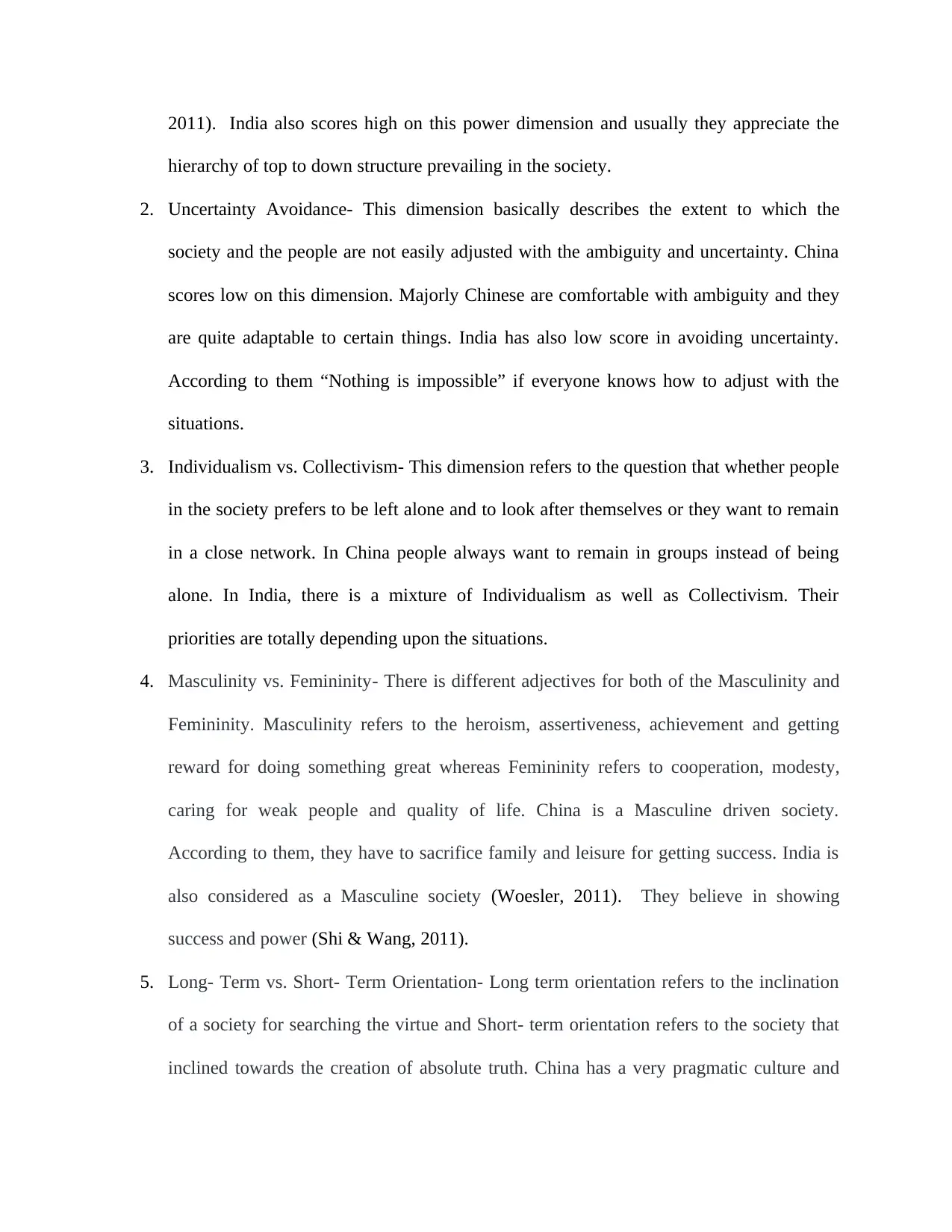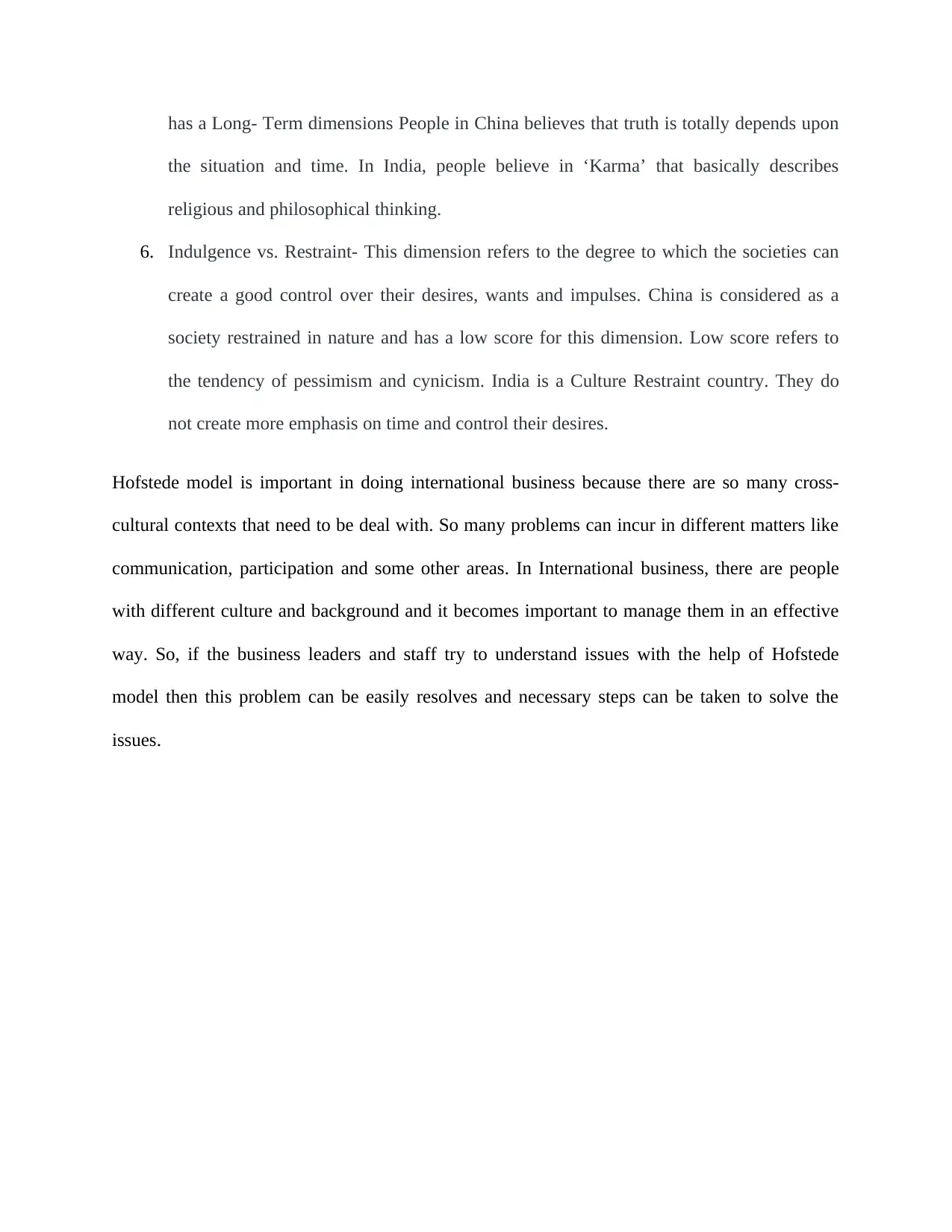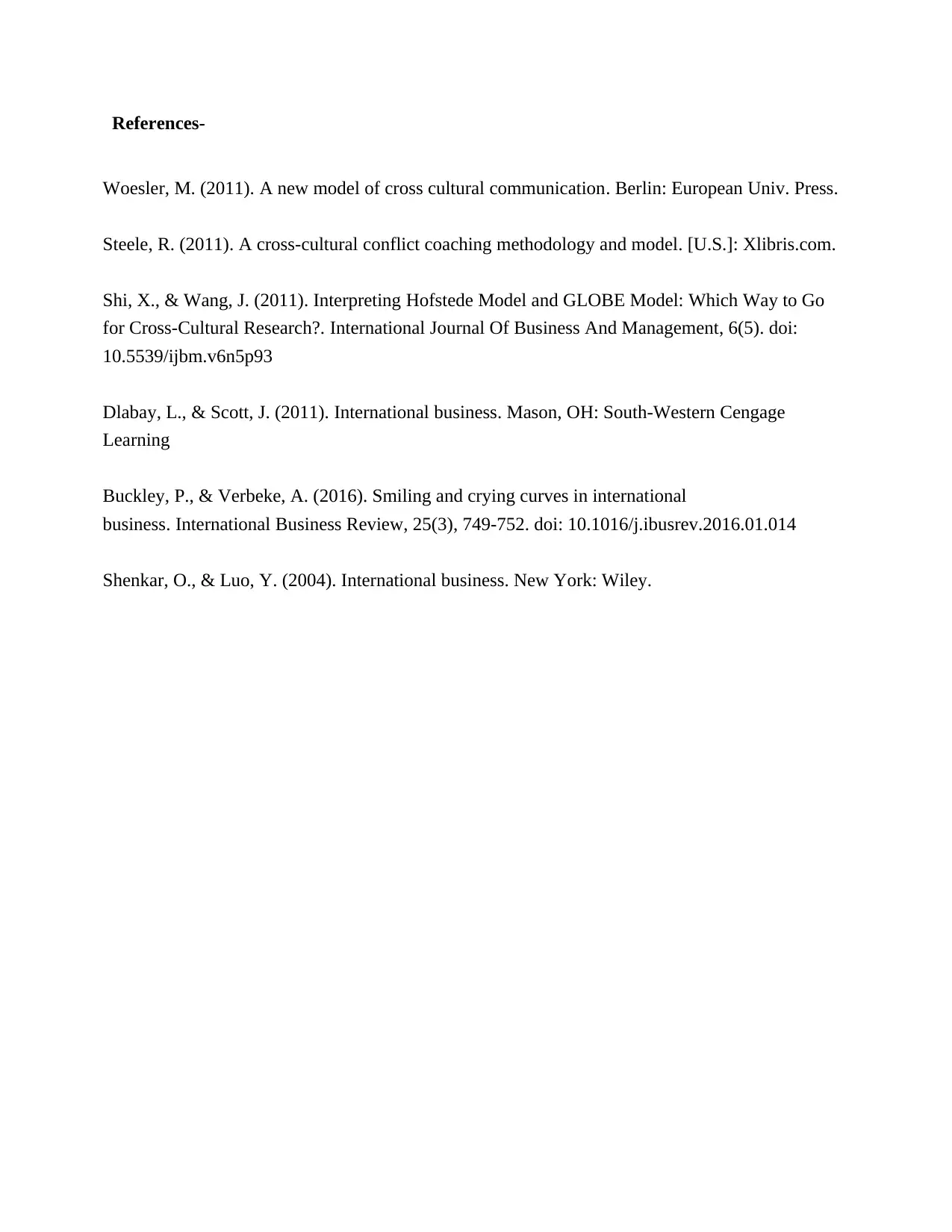Applying Hofstede's Dimensions to International Business Strategy
VerifiedAdded on 2023/06/11
|5
|1031
|453
Essay
AI Summary
This essay examines the application of Hofstede's Cultural Dimensions in the context of international business. It explains each of the six dimensions—Power Distance, Uncertainty Avoidance, Individualism vs. Collectivism, Masculinity vs. Femininity, Long-Term vs. Short-Term Orientation, and Indulgence vs. Restraint—and provides examples of how these dimensions manifest in different cultures, specifically China and India. The essay highlights the importance of understanding these cultural differences for effective cross-cultural communication and management in international business, emphasizing that leveraging the Hofstede model can help business leaders and staff navigate potential issues and make informed decisions in diverse cultural settings. The solution also includes a list of references.

International Business
Paraphrase This Document
Need a fresh take? Get an instant paraphrase of this document with our AI Paraphraser

International business refers to the business activities that take place across the border. It can be
defines as an organization that basically involved in the purchase and sell off the products and
services across international boundaries. There are so many differences that create an impact on
the international business activities like cultural differences and economic differences (Steele,
2011).
Hofstede Cultural dimensions are devised by Geert Hofstede that is basically used for cross-
cultural communication. There are people living in a society with different cultures and different
values. It helps in to finding out the impact of the same. It provides assistance in doing factor
analysis by describing the relationship between the behavior and the values. It majorly finds the
different cultural aspects and gives them a rating by doing comparative analysis.
International business needs all these requirements to be fulfilled and analyze the different
features of the business that helps in managing the international business with the people belong
to different culture (Buckley & Verbeke, 2016). It also helps manager to understand several
things. The six cultural dimensions of Hofstede Paradigm are-
1. Power distance- Power distance refers to the extent to which the less powerful members
are accepted in the society and there is also an expectation that distribution of power has
been done unequally (Shenkar & Luo, 2004). It has been seen that the powerful members
in the society are always provided with the extra powers. Power distance basically refers
to inequality. In case of Chine, they possessed a higher rank in power distance in 80s.
According to them, inequalities are acceptable in the societies. In their country, the
relationship between subordinate- superior tends to be polarized and there is not even a
single percent defense against the power abuse done by the superiors (Dlabay & Scott,
defines as an organization that basically involved in the purchase and sell off the products and
services across international boundaries. There are so many differences that create an impact on
the international business activities like cultural differences and economic differences (Steele,
2011).
Hofstede Cultural dimensions are devised by Geert Hofstede that is basically used for cross-
cultural communication. There are people living in a society with different cultures and different
values. It helps in to finding out the impact of the same. It provides assistance in doing factor
analysis by describing the relationship between the behavior and the values. It majorly finds the
different cultural aspects and gives them a rating by doing comparative analysis.
International business needs all these requirements to be fulfilled and analyze the different
features of the business that helps in managing the international business with the people belong
to different culture (Buckley & Verbeke, 2016). It also helps manager to understand several
things. The six cultural dimensions of Hofstede Paradigm are-
1. Power distance- Power distance refers to the extent to which the less powerful members
are accepted in the society and there is also an expectation that distribution of power has
been done unequally (Shenkar & Luo, 2004). It has been seen that the powerful members
in the society are always provided with the extra powers. Power distance basically refers
to inequality. In case of Chine, they possessed a higher rank in power distance in 80s.
According to them, inequalities are acceptable in the societies. In their country, the
relationship between subordinate- superior tends to be polarized and there is not even a
single percent defense against the power abuse done by the superiors (Dlabay & Scott,

2011). India also scores high on this power dimension and usually they appreciate the
hierarchy of top to down structure prevailing in the society.
2. Uncertainty Avoidance- This dimension basically describes the extent to which the
society and the people are not easily adjusted with the ambiguity and uncertainty. China
scores low on this dimension. Majorly Chinese are comfortable with ambiguity and they
are quite adaptable to certain things. India has also low score in avoiding uncertainty.
According to them “Nothing is impossible” if everyone knows how to adjust with the
situations.
3. Individualism vs. Collectivism- This dimension refers to the question that whether people
in the society prefers to be left alone and to look after themselves or they want to remain
in a close network. In China people always want to remain in groups instead of being
alone. In India, there is a mixture of Individualism as well as Collectivism. Their
priorities are totally depending upon the situations.
4. Masculinity vs. Femininity- There is different adjectives for both of the Masculinity and
Femininity. Masculinity refers to the heroism, assertiveness, achievement and getting
reward for doing something great whereas Femininity refers to cooperation, modesty,
caring for weak people and quality of life. China is a Masculine driven society.
According to them, they have to sacrifice family and leisure for getting success. India is
also considered as a Masculine society (Woesler, 2011). They believe in showing
success and power (Shi & Wang, 2011).
5. Long- Term vs. Short- Term Orientation- Long term orientation refers to the inclination
of a society for searching the virtue and Short- term orientation refers to the society that
inclined towards the creation of absolute truth. China has a very pragmatic culture and
hierarchy of top to down structure prevailing in the society.
2. Uncertainty Avoidance- This dimension basically describes the extent to which the
society and the people are not easily adjusted with the ambiguity and uncertainty. China
scores low on this dimension. Majorly Chinese are comfortable with ambiguity and they
are quite adaptable to certain things. India has also low score in avoiding uncertainty.
According to them “Nothing is impossible” if everyone knows how to adjust with the
situations.
3. Individualism vs. Collectivism- This dimension refers to the question that whether people
in the society prefers to be left alone and to look after themselves or they want to remain
in a close network. In China people always want to remain in groups instead of being
alone. In India, there is a mixture of Individualism as well as Collectivism. Their
priorities are totally depending upon the situations.
4. Masculinity vs. Femininity- There is different adjectives for both of the Masculinity and
Femininity. Masculinity refers to the heroism, assertiveness, achievement and getting
reward for doing something great whereas Femininity refers to cooperation, modesty,
caring for weak people and quality of life. China is a Masculine driven society.
According to them, they have to sacrifice family and leisure for getting success. India is
also considered as a Masculine society (Woesler, 2011). They believe in showing
success and power (Shi & Wang, 2011).
5. Long- Term vs. Short- Term Orientation- Long term orientation refers to the inclination
of a society for searching the virtue and Short- term orientation refers to the society that
inclined towards the creation of absolute truth. China has a very pragmatic culture and
⊘ This is a preview!⊘
Do you want full access?
Subscribe today to unlock all pages.

Trusted by 1+ million students worldwide

has a Long- Term dimensions People in China believes that truth is totally depends upon
the situation and time. In India, people believe in ‘Karma’ that basically describes
religious and philosophical thinking.
6. Indulgence vs. Restraint- This dimension refers to the degree to which the societies can
create a good control over their desires, wants and impulses. China is considered as a
society restrained in nature and has a low score for this dimension. Low score refers to
the tendency of pessimism and cynicism. India is a Culture Restraint country. They do
not create more emphasis on time and control their desires.
Hofstede model is important in doing international business because there are so many cross-
cultural contexts that need to be deal with. So many problems can incur in different matters like
communication, participation and some other areas. In International business, there are people
with different culture and background and it becomes important to manage them in an effective
way. So, if the business leaders and staff try to understand issues with the help of Hofstede
model then this problem can be easily resolves and necessary steps can be taken to solve the
issues.
the situation and time. In India, people believe in ‘Karma’ that basically describes
religious and philosophical thinking.
6. Indulgence vs. Restraint- This dimension refers to the degree to which the societies can
create a good control over their desires, wants and impulses. China is considered as a
society restrained in nature and has a low score for this dimension. Low score refers to
the tendency of pessimism and cynicism. India is a Culture Restraint country. They do
not create more emphasis on time and control their desires.
Hofstede model is important in doing international business because there are so many cross-
cultural contexts that need to be deal with. So many problems can incur in different matters like
communication, participation and some other areas. In International business, there are people
with different culture and background and it becomes important to manage them in an effective
way. So, if the business leaders and staff try to understand issues with the help of Hofstede
model then this problem can be easily resolves and necessary steps can be taken to solve the
issues.
Paraphrase This Document
Need a fresh take? Get an instant paraphrase of this document with our AI Paraphraser

References-
Woesler, M. (2011). A new model of cross cultural communication. Berlin: European Univ. Press.
Steele, R. (2011). A cross-cultural conflict coaching methodology and model. [U.S.]: Xlibris.com.
Shi, X., & Wang, J. (2011). Interpreting Hofstede Model and GLOBE Model: Which Way to Go
for Cross-Cultural Research?. International Journal Of Business And Management, 6(5). doi:
10.5539/ijbm.v6n5p93
Dlabay, L., & Scott, J. (2011). International business. Mason, OH: South-Western Cengage
Learning
Buckley, P., & Verbeke, A. (2016). Smiling and crying curves in international
business. International Business Review, 25(3), 749-752. doi: 10.1016/j.ibusrev.2016.01.014
Shenkar, O., & Luo, Y. (2004). International business. New York: Wiley.
Woesler, M. (2011). A new model of cross cultural communication. Berlin: European Univ. Press.
Steele, R. (2011). A cross-cultural conflict coaching methodology and model. [U.S.]: Xlibris.com.
Shi, X., & Wang, J. (2011). Interpreting Hofstede Model and GLOBE Model: Which Way to Go
for Cross-Cultural Research?. International Journal Of Business And Management, 6(5). doi:
10.5539/ijbm.v6n5p93
Dlabay, L., & Scott, J. (2011). International business. Mason, OH: South-Western Cengage
Learning
Buckley, P., & Verbeke, A. (2016). Smiling and crying curves in international
business. International Business Review, 25(3), 749-752. doi: 10.1016/j.ibusrev.2016.01.014
Shenkar, O., & Luo, Y. (2004). International business. New York: Wiley.
1 out of 5
Related Documents
Your All-in-One AI-Powered Toolkit for Academic Success.
+13062052269
info@desklib.com
Available 24*7 on WhatsApp / Email
![[object Object]](/_next/static/media/star-bottom.7253800d.svg)
Unlock your academic potential
Copyright © 2020–2026 A2Z Services. All Rights Reserved. Developed and managed by ZUCOL.




